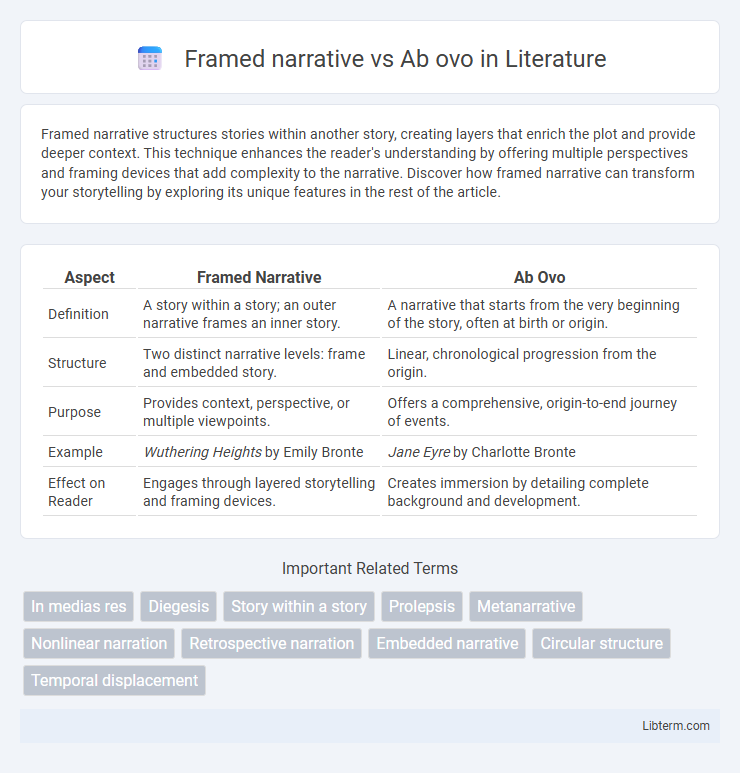Framed narrative structures stories within another story, creating layers that enrich the plot and provide deeper context. This technique enhances the reader's understanding by offering multiple perspectives and framing devices that add complexity to the narrative. Discover how framed narrative can transform your storytelling by exploring its unique features in the rest of the article.
Table of Comparison
| Aspect | Framed Narrative | Ab Ovo |
|---|---|---|
| Definition | A story within a story; an outer narrative frames an inner story. | A narrative that starts from the very beginning of the story, often at birth or origin. |
| Structure | Two distinct narrative levels: frame and embedded story. | Linear, chronological progression from the origin. |
| Purpose | Provides context, perspective, or multiple viewpoints. | Offers a comprehensive, origin-to-end journey of events. |
| Example | Wuthering Heights by Emily Bronte | Jane Eyre by Charlotte Bronte |
| Effect on Reader | Engages through layered storytelling and framing devices. | Creates immersion by detailing complete background and development. |
Understanding Framed Narrative: Definition and Purpose
Framed narrative is a literary structure where a story is embedded within another story, serving to provide context and perspective to the main narrative. This technique often enhances readers' engagement by creating multiple layers of meaning and guiding interpretation through the frame narrative's narrator or setting. In contrast, ab ovo starts the story from the very beginning chronologically, offering a straightforward, linear progression without external framing.
What is Ab Ovo Storytelling?
Ab ovo storytelling refers to a narrative technique that begins from the very start of the story's chronological events, providing a detailed background and origin before reaching the main plot. This approach contrasts with framed narratives, where the main story is embedded within another narrative, often starting in medias res or at a significant moment. Ab ovo offers deep context and character development by unfolding events sequentially from the beginning.
Key Differences Between Framed Narrative and Ab Ovo
Framed narrative presents a story within a story, where an outer frame introduces and concludes the inner narrative, creating multiple layers of perspective and enhancing thematic depth. Ab ovo storytelling begins strictly from the chronological start of the plot, delivering a linear, cause-and-effect progression without narrative framing. The key difference lies in structure and temporal approach: framed narrative uses a peripheral frame to contextualize the inner tale, while ab ovo unfolds events sequentially from the very beginning.
Historical Origins of Framed Narratives
Framed narratives trace their historical origins to ancient literary traditions, notably exemplified in works such as "One Thousand and One Nights" and Geoffrey Chaucer's "The Canterbury Tales," where stories are embedded within an overarching narrative frame. This structure contrasts with the ab ovo technique, which begins a story from its chronological starting point, often the "egg" or origin, as seen in classical epics like Homer's "Iliad." The framed narrative allows for complex storytelling, enabling multiple perspectives and temporal shifts that have deeply influenced the evolution of narrative forms across cultures and literary periods.
Evolution of Ab Ovo in Literary Tradition
The ab ovo narrative, originating from Latin meaning "from the egg," begins a story at its chronological starting point, offering a linear progression from origin to conclusion. This method evolved through classical literature and medieval texts where detailed chronological exposition anchored complex storylines, reinforcing cause-and-effect relationships. Over time, the ab ovo approach contrasted with framed narratives, which introduced stories within stories, reflecting a shift towards layered storytelling and thematic complexity in modern literary tradition.
Advantages of Using a Framed Narrative Structure
Framed narrative structures enhance storytelling by providing a clear context and perspective, allowing readers to engage more deeply with the embedded story. This approach offers flexibility in plot development and enriches character background through multiple layers of narration. Framed narratives also create suspense and thematic resonance, as the outer story can comment on or contrast with the inner tale, deepening the reader's understanding.
Strengths of Ab Ovo Storytelling: A Narrative Analysis
Ab ovo storytelling, starting from the very beginning of a story, provides a comprehensive foundation that enriches character development and plot coherence, ensuring audiences fully grasp the motivations and contexts influencing events. This linear approach facilitates a clear narrative progression, minimizing confusion and allowing for a deeper emotional connection with the characters. By presenting exhaustive background information, ab ovo structures foster immersion and enhance thematic resonance throughout the narrative arc.
Examples of Framed Narratives in Literature and Film
Framed narratives, such as Mary Shelley's "Frankenstein" and the film "The Princess Bride," employ a story within a story structure that enhances thematic depth and perspective. In contrast to the ab ovo technique, which begins a tale from the very start of events, framed narratives use a primary storyteller to introduce secondary tales, enriching context and narrative layers. Classic film noir like "The Big Sleep" also utilizes framed narration to deepen mystery and character complexity through multiple viewpoints.
Notable Works Starting Ab Ovo: Impact and Effect
Notable works starting ab ovo, such as Homer's *Iliad* and James Joyce's *Ulysses*, immerse readers immediately from the chronological beginning, providing comprehensive background and character development that enhance narrative depth. This technique creates a linear, cause-and-effect storytelling structure that clearly links events, intensifying emotional engagement and thematic clarity. In contrast, framed narratives like Emily Bronte's *Wuthering Heights* use embedded storytelling to add layers of perspective and complexity but may delay direct immersion into the main plot.
Choosing the Right Narrative: Factors and Considerations
Choosing the right narrative between framed narrative and ab ovo depends on the desired storytelling impact and reader engagement. Framed narratives offer multiple perspectives and a layered structure, ideal for complex plots and character insights, while ab ovo provides a chronological, straightforward account from the beginning. Consider factors such as thematic complexity, pacing, and the need for suspense when deciding the most effective narrative form.
Framed narrative Infographic

 libterm.com
libterm.com